It was a deadlift this time. There I was on the gym floor, half bent and looking like some sort of sick animal, afraid to stand up. Again. Last time it was moving a couch; before that it was reaching under a car seat; before that it was getting out of bed the wrong way. A familiar future unspooled before me: a week or two on the couch in cranky agony, a month of tenuous recovery, and, as with the approximately 80 percent of Americans who will suffer from back pain, a lifetime of knowing that it’ll all probably happen again.
But before I could straighten up and try to drag my body out of the gym, a trainer called over to Dara Lampe, one of the gym’s massage therapists. Coaxing me onto a nearby table, Lampe asked if I’d ever had a massage to treat my back pain. Of course not, I thought. No muscle could produce this hellpain. Like plenty of other folks with back pain, I was sure I had a disk problem. Herniated disks—when the jellylike cushions between your vertebrae bulge out of place and squish against your nerves—affect men twice as often as women. They’re responsible for the kind of anguish that compels almost half a million Americans to get intensive spinal-fusion surgeries each year, even though studies show that these surgical interventions help barely a third of sufferers. Herniated disks sound serious, and each time my back left me immobilized, I was convinced they were the culprit and never gave my back muscles any thought.
Lampe, a beacon of grace, nodded sympathetically. Then she rolled me over, jammed a knuckle beneath my bottommost rib, and set my brain on fire. Lampe had found my quadratus lumborum (QL), a little-known muscle that plays a big role in back pain. I swore as she manipulated the part of my back in which a boxer would lay a kidney shot, experiencing a whole-body rainbow of agony and release. What I learned from that was a revelation that would change my relationship with my spine—and could reduce the pain that millions of Americans live with each year.
Why a “slipped” disk probably isn’t causing your back pain
Like kale and the Kardashians, herniated disks get way more attention than they deserve. The truth is that muscles, ligaments, and arthritis are responsible for about 85 percent of back-pain episodes. “Only a small percentage of patients have a herniated disk, and an even smaller percent will have something that requires surgery,” says Matthew Varacallo, M.D., an orthopedic surgeon specializing in sports medicine and joint reconstruction at Penn Highlands Healthcare in DuBois, Pennsylvania. Google searches might make you think you have a herniated disk, Lampe says, “but I’d say the QL is the most overlooked muscle when it comes to low back pain.” Dr. Varacallo adds, “Nobody comes in and says, ‘I have a strained QL.’ ” But they probably should.
The QL is one of the deepest muscles of the trunk. (Technically, that’s QLs, since there’s one on each side of your spine.) It fans out from the vertebrae just below your rib cage down to your iliac crest, at the top of your hip bone. It’s like a tension cable that keeps your spine upright and your entire trunk steady. It’s not designed to do the job alone; your glutes, along with all of the other trunk muscles, help out.
Unless you’re a typical desk worker, that is. Thanks to poor posture and prolonged sitting, these helper muscles do practically nothing all day, so your QL potentially works harder and harder to pick up the slack. You go to stand up or deadlift, and the QL, now tense from being on duty by itself, is stuck with even more work. Which it’s not designed to do, and you feel it in the form of a spasm or low back pain.
So what do you do when you’re in my shoes, crumpled on the gym floor and terrified at the prospect of standing up? Lampe’s targeted massage helped loosen my spasming QL (I had a couple more massages over the next two weeks) and shortened my recovery time. But that was no long-term solution. Although I’m still sitting at my desk all day, trying my best not to hunch over my keyboard, I now break things up with simple QL stretches (see below) to keep it agile and less spasm-prone.
I’m working with a trainer, too, on exercises (see below) for my dilapidated trunk stabilizers and hip muscles, plus weighted squats for my glutes and endless lat pulls for my upper back. Nobody’s gonna say, “Nice QL!” if they haven’t seen me for a while. But if the time I spend on the muscle prevents it from taking me down, I can keep on training everything else.
Best Stretches and Exercises for Back Pain
Daniel Giordano, D.P.T., C.S.C.S., cofounder of Bespoke Treatments in New York City and an MH advisor, sees a lot of patients with back pain caused by the quadratus lumborum, which too often gets overworked in exactly the wrong way. He prescribes these stretches and these strengthening exercises to make things right:
Stretches you should do:
Mobility Ball Manipulation
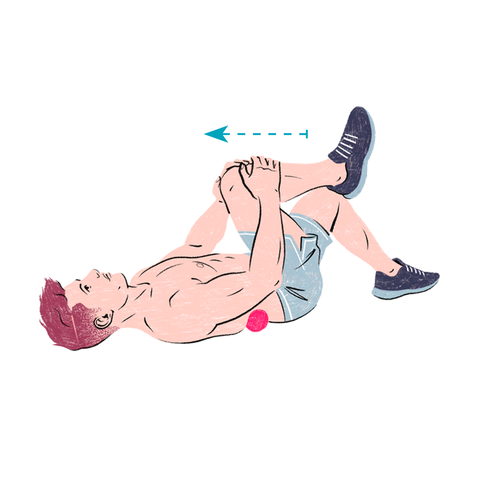
Ben Mounsey-Wood
Lying on your back—knees bent, feet on the floor—place a lacrosse ball to the right of your spine, a few fingers’ width above your pelvic bone. Bring your right knee to your chest, hold 5 seconds, and release. Repeat 10 times; switch sides.
Lateral Line Stretch

Ben Mounsey-Wood
Standing up with your feet hip-width apart, move your right foot behind your left, planting it at approximately 7 or 8 o’clock. Stretch your right hand
to the ceiling and, moving from your hips, not your waist, gently lean toward the left. Hold 5 seconds. Repeat 10 times; switch sides.
90/90 QL Stretch
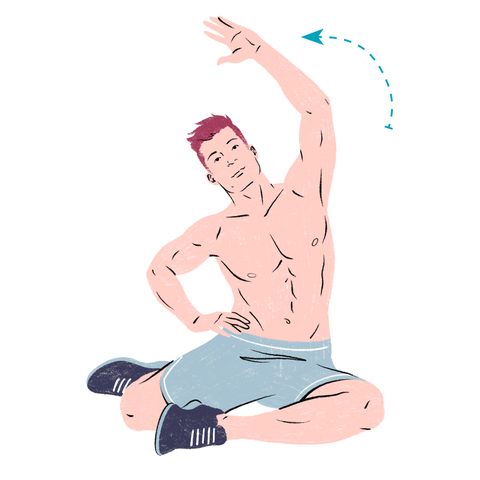
Ben Mounsey-Wood
Sit on the floor with knees bent at 90 degrees, right foot behind you, left foot in front of your right knee. With your chest tall and pelvis pushed to the floor, raise your left hand up and over your body. Do ten 5-second stretches; switch sides.
Strengthening Exercises
Plank Pull-Through
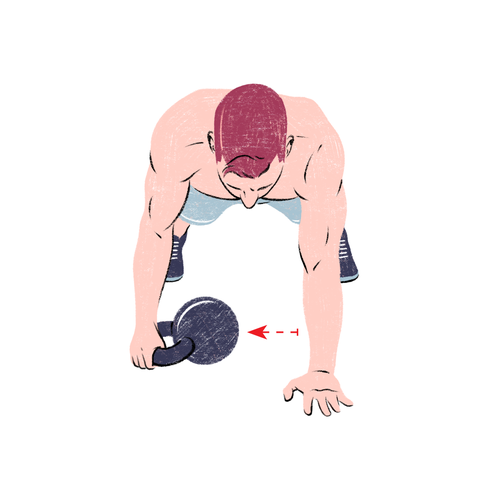
Ben Mounsey-Wood
Get in a high plank, feet shoulder-width apart. Place a weight behind your left hand, then use your right to drag it across the floor under your chest. Keep hips and shoulders level; don’t arch your back. Repeat on the other side for 1 rep. Do 3 sets of 8.
Side Plank with Rotation
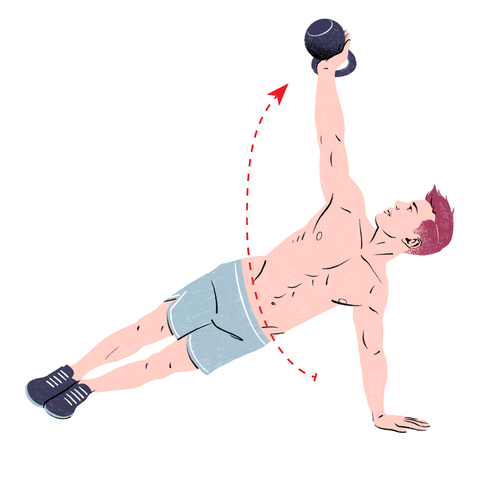
.
In a high side plank, pick up a light weight from beneath your body. Rotate your torso to lift the weight into the air, then rotate it down. Follow the weight with your focus. Do 3 sets of 8 reps on each side.
Farmer’s Carry
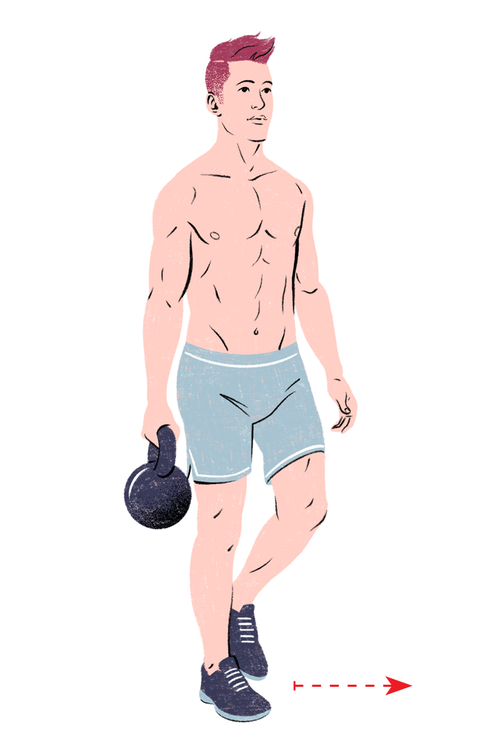
.
Hold a kettlebell—about 10kg—in one hand by your side. Keeping your torso erect and hips and shoulders level, walk 10 paces, then turn around and come back. Switch hands after each carry. If you lose stability, the exercise is done. Ideally, walk 10 paces 8 times.
Source: Read Full Article
